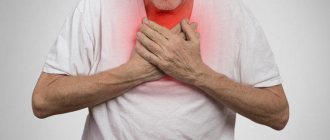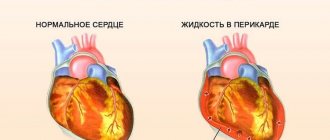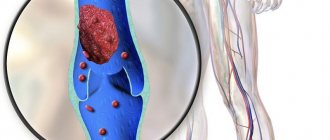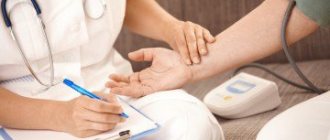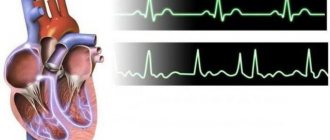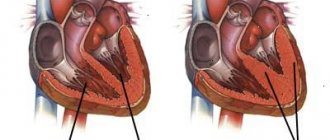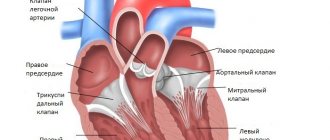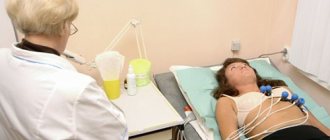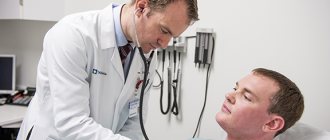© Author: A. Olesya Valerievna, candidate of medical sciences, practicing physician, teacher at a medical university, especially for SosudInfo.ru (about the authors)
Without exaggeration, the heart is considered the main organ in the circulatory system, without which blood delivery to the internal organs is impossible. When it is damaged, hemodynamics are disrupted, and cardiac rupture (HR) makes blood movement impossible, and the patient dies from shock.
Rupture of the heart muscle - myocardium - is a violation of its integrity, which most often occurs due to a heart attack. Contrary to popular belief, fright or severe fear cannot cause a rupture on its own, because the heart is a powerful muscular organ, and for its damage prerequisites are needed in the form of changes in the myocardium.
Elderly people, especially women, as well as patients suffering from diabetes, hypertension, and chronic cardiac ischemia are more susceptible to heart rupture. Taking certain medications and late initiation of treatment for a heart attack may be accompanied by a slowdown in scar formation, which creates the preconditions for rupture. Rupture of the heart vessels, the initial part of the aorta, is provoked by a deep atherosclerotic process, vasculitis.
Causes of heart rupture
The main causes of heart rupture include:
- Heart attack. The likelihood of myocardial rupture increases significantly during the first two weeks after the disease.
- Closed chest injury. They occur when there is a blow to the heart area, a fall from a height, a blow with a fist or foot, or compression of the chest.
- Open heart surgery, direct or indirect cardiac massage. In this case, this pathology develops when the manipulation is performed incorrectly.
- Infectious or inflammatory lesions of the myocardium. As a result of such processes, the inner lining of the heart is damaged. It becomes low-elastic, inextensible, and the tone of the heart muscle decreases.
- Tumors, congenital heart defects (CHD), metabolic changes. All this also leads to disruption of the integrity of the muscular lining of the heart.
Closed chest injury is a possible cause of cardiac rupture.
Rupture can also occur with pericarditis or hemopericarditis. A large amount of fluid (blood) accumulates in the pericardium. Compression of the heart occurs. This can lead to the development of ischemia and rupture of the heart muscle.
The common belief that the heart can burst from severe fright or stress is not true.
Possible complications
The main complications are as follows:
- If a person has a rupture of the heart muscle, then without proper medical care he dies. To prevent this from happening, he needs urgent surgery. If the gap is small, then a person can live only two months without surgery.
- The forecasts, unfortunately, are disappointing, because almost half of the patients may die, even if the operation was performed on time and with proper quality. The thing is that the sutures placed during suturing often come apart.
If you start treatment in a timely manner, it is possible to eliminate complications.
Risk factors
The question of why heart rupture occurs and what causes it can be answered unequivocally. This condition can occur in people with risk factors. These factors include:
- Female.
- Elderly age.
- Arterial hypertension.
- Atrial fibrillation.
- Paroxysmal heart rhythm disturbances.
- Treatment of myocardial infarction not started quickly enough.
- Autoimmune connective tissue diseases.
- Chronic heart diseases: coronary disease, congenital malformations.
- The patient is severely exhausted.
- Abuse of corticosteroid hormones (prednisolone, dexamethasone), other drugs.
Some experts also believe that poor heredity and genetic predisposition are predisposing factors for heart development.
Types of heart ruptures
Heart ruptures are classified depending on the location and timing of occurrence. Sometimes, after a massive myocardial infarction, rapid rupture of the heart can occur. In this case, death occurs instantly. If the tear does not extend to the entire depth of the muscle, then after treatment the person’s condition improves.
The existing classification distinguishes several types of cardiac rupture:
- Heart rupture with damage to the outer cardiac membrane, chest, and other internal organs.
- Rupture of the heart without rupture of its membranes, but with injuries to one or more ribs.
- Rupture of the heart without damage to the skin and chest.
Also, heart rupture can be late or early. Early - develops in the first 24 hours after myocardial infarction. Late rupture occurs at a later date. It is caused by insufficient healing of the post-infarction scar or its damage.
Depending on the location of the pathological process
Based on location, the following types of myocardial rupture are distinguished:
- External (or external) rupture. There is a through violation of the integrity of the heart wall. With this pathology, the walls of the right or left ventricles or atria are injured. The spilled blood under the influence of high pressure completely fills the pericardial cavity, and hemopericarditis develops. The heart is compressed by a large volume of fluid, its contraction becomes difficult, and acute cardiac tamponade develops. The blood supply to the brain and all internal organs is disrupted, and cardiogenic shock develops. Cardiac arrest occurs.
- Internal break. The integrity of the internal structures of the heart is compromised. The interventricular or interatrial septum, papillary muscles, mitral or tricuspid valve are damaged. When the interatrial septum is ruptured, the contractility of the heart muscle is impaired, which leads to deterioration of hemodynamics. Intense pain in the chest, shortness of breath, acrocyanosis, and pallor occurs. Rupture of the interventricular septum is characterized by more pronounced clinical symptoms. Death occurs faster than in the previous case. If the papillary muscles are torn, serious circulatory problems occur.
Thus, the external cardiac rupture develops rapidly. In this case, it is almost never possible to save a person.
With an internal heart rupture, a person can live up to 7–10 days. When appropriate measures are taken, prompt resuscitation, and adequate treatment, it is possible to normalize the patient’s condition.
By date of appearance
According to the timing of occurrence, cardiac rupture occurs:
- One-step. This condition develops acutely. It is an early complication of myocardial infarction, coronary artery disease, and destructive changes in the heart. There is a sudden cessation of blood circulation and cardiac arrest. Death occurs within a few minutes. Resuscitation of the patient is impossible even with immediate medical assistance.
- Slow flowing. Develops during the first 7 days after a heart attack. In this case, the patient experiences pale skin, cold sticky sweat, and decreased blood pressure.
Cardiac rupture is simultaneous.
Simultaneous cardiac rupture accounts for 50 to 60% of all types of ruptures.
Slow current - accounts for approximately 40 - 45% of all cases.
Prevention
Prevention of heart ruptures comes down to timely detection and treatment of heart and vascular diseases and proper provision of care to patients with myocardial infarction. To prevent such heart damage, the following rules should be followed:
- Monitor your cholesterol levels and follow all doctor’s recommendations to eliminate hypercholesterolemia.
- Regularly measure blood pressure and maintain it within normal limits (from 90/60 to 140/90 mm Hg).
- To refuse from bad habits.
- Eat properly.
- Seek medical help if you experience heart pain lasting more than 5 minutes.
- If you are diagnosed with coronary heart disease, regularly visit your doctor and follow all his recommendations about clinical observation, treatment and prevention.
- Immediately call an ambulance if you suspect a myocardial infarction and properly provide first aid to the patient.
- Carefully transport patients with or suspected of myocardial infarction to a medical facility.
- Strictly follow all doctor’s recommendations after myocardial infarction regarding motor activity.
- To prevent the occurrence of conditions (heavy lifting, coughing, vomiting, straining with constipation) that cause an increase in pressure in the cardiac ventricles among people at increased risk of heart rupture.
Heart rupture is a severe complication of cardiovascular diseases or injuries and requires immediate cardiac surgery. In many cases, this condition leads to the death of the patient even at the prehospital stage. In addition, even timely surgery does not always save the patient’s life, and in approximately 50% of such patients death occurs due to self-cutting sutures.
General symptoms
Clinical manifestations of cardiac rupture depend on the nature and type of damage. Their severity is determined by the degree of hemodynamic disturbance, localization of the lesion and the presence of hemopericarditis.
Common symptoms of heart rupture include:
- A sharp decrease in blood pressure.
- Increased sweating, asthma attack.
- Thread-like pulse of weak filling.
- Severe intense pain behind the sternum or at the apex of the heart. The pain radiates under the left shoulder blade, into the left arm or shoulder.
- Increased respiratory rate, inspiratory or expiratory shortness of breath.
- Sudden pallor of the skin.
- Blue discoloration of the tip of the nose, ears, nasolabial triangle, lips.
- Loss of consciousness or severe dizziness.
- Cough with foam, hemoptysis.
- Swelling of the neck veins.
In some cases, it is possible to develop extrasystolic arrhythmia, right and left bundle branch block, atrial fibrillation, and paroxysmal arrhythmia.
With an internal or slow rupture of the heart, heaviness appears in the right hypochondrium, an increase in the size of the liver, swelling of the lower extremities, and accumulation of fluid in the abdominal cavity.
The patient experiences severe anxiety and a feeling of fear. The patient tosses about in bed and complains of cutting or burning chest pain.
With an external or simultaneous rupture of the heart, all symptoms quickly increase, swelling increases, pressure decreases, and a state of shock develops. It is not possible to save the patient. The electrocardiogram shows cardiac arrest.
When the papillary muscles or interatrial septum are ruptured, the patient develops pulmonary edema. The pressure decreases, worsens, and foamy sputum is released.
Diagnostics
Methods for diagnosing cardiac rupture include:
- Visual examination of the patient, measurement of heart rate, respiration, blood pressure. Severe pallor of the skin, threadlike pulse, and acrocyanosis are detected. The pressure drops to critical levels.
- Auscultation. Heart sounds are muffled and arrhythmic.
- Echo ECG (or ultrasound of the heart). Using this method, you can detect fluid (blood) in the pericardium and determine signs of cardiac tamponade. A violation of the diastolic filling of the right ventricle is detected. This leads to expansion of the inferior vena cava, increasing the speed of blood flow in the hepatic veins. There is also a decrease in the cavity of the right ventricle at the end of expiration, stretching of the left atrium in the diastole phase and its sharp compression in systole. The movement of blood between the left ventricle and the atrium decreases, and the volume of the right chambers of the heart overflows.
- Catheterization (probing) of the atria, ventricles or pulmonary artery. A special catheter is used for this. It is administered through an artery in the arm or leg. Then, under X-ray control, it is brought to the heart cavities. This method allows you to measure pressure in the atria and ventricles, obtain images of the coronary vessels, and determine the integrity of the ventricular myocardium and pericardium.
- Troponin test. A positive result means that special proteins (troponins) are released into the blood. These compounds are found in the heart muscle and contribute to normal myocardial contraction. Their entry into the blood means that damage (necrosis) of the heart muscle has occurred.
Auscultation is a method for diagnosing cardiac rupture.
Also, to diagnose cardiac rupture, a general blood test, coagulogram, and biochemical study are performed. Using these methods, it is possible to identify complications from internal organs and determine the tendency to increased thrombosis or bleeding.
Treatment options
At the first signs of the disease and the development of cardiogenic shock, the patient is given a course of intensive therapy. This treatment contributes to a short-term improvement in the patient’s condition and helps him undergo further surgery.
The main treatment for heart rupture is surgery. The choice of operation depends on the degree, size, location of the damage and the technical capabilities of the cardiology hospital.
Intensive therapy
Treatment of cardiogenic shock, which develops when the heart ruptures, includes:
- Oxygen therapy. The patient is given oxygen through a special catheter or mask.
- Intravenous administration of drugs to increase blood pressure and normalize cardiac activity.
- Drip infusion of plasma replacement fluids.
- Administration of cardiac glycosides.
Oxygen therapy is a method of treating heart rupture.
If necessary, artificial ventilation of the lungs is performed. With the development of pulmonary edema, bronchodilators, glucocorticoids and diuretics are administered intravenously.
Surgical options
In case of heart rupture, the following types of surgical interventions are performed:
- Suturing the tear or applying a patch. The operation is performed on an open heart.
- Coronary artery bypass grafting with simultaneous elimination of the defect.
- Applying a patch to a tear using endovascular techniques.
- Heart transplantation.
The latter treatment method is rarely used. The patient is placed on a waiting list for selection of a suitable organ.
Features of injury
The integrity of the walls of the heart can be damaged, namely ruptured, as a result of a number of reasons. The septum between the ventricles of the heart or the muscle involved in the operation of the valve may also rupture.
Such phenomena pose a threat to human life, therefore, at the first signs, the patient must stop exposing the body to any kind of stress and call an ambulance. The ability to save the patient’s life depends on how quickly specialists establish the correct diagnosis and begin treatment.
The picture below shows a heart being ruptured.
Heart rupture (photo)
